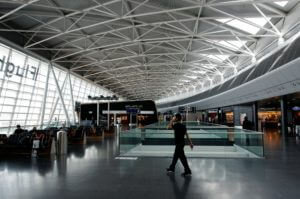Considering that 80% of mobile traffic is generated indoors, especially in public locations, when employees or customers experience dead spots or dropped calls, it becomes not only an inconvenience but can be a safety hazard. When it comes to providing sufficient network coverage and capacity solutions—you won’t find a “one-size-fits-all” solution; but understanding DAS and small cells (and when to use them) plays an important role. The details of a project, demand for bandwidth and objectives of the stakeholders will ultimately dictate the need for DAS and small cells- the keys to connectivity.
 Understanding DAS. What is a Distributed Antenna System?
Understanding DAS. What is a Distributed Antenna System?
Distributed antenna systems improve wireless frequency coverage for large locations such as stadiums, hospitals, office buildings, hotels, airports, etc. Each of these commercial locations has a unique set of challenges that can affect the design of the DAS solution. Long before small cells were invented, DAS, often referred to as the original small cell, was providing mobile coverage to large buildings, venues and outdoor space. The technology has been around for more than 20 years, but as consumers want to text, talk and tweet every second of every day, the demand for innovative DAS solutions continues to increase at a rapid rate.
DAS works by carrying a signal over fiber from a base station and head-end, through hubs and out to a series of remote antennas. A fiber-fed DAS can extend for 15 miles (or more), support multiple carriers, thousands of subscribers and carry multiple frequency bands.
What Are Small Cells?
Small cell technology (femtocells, picocells, metrocells, etc.), on the other hand, are miniature self-contained radio units that mount on a wall or ceiling providing mobile services for small-to mid-sized venues. They are single-frequency, single-service devices; similar to a Wi-Fi “hotspot,” they are best for filling in coverage gaps. Although small cells require their own backhaul with limited power and range (10 meters to 2 kilometers), they complement larger macro base-stations to provide faster data speeds and permit greater subscriber capacity.
DAS Plus Small Cells: Finding the Right Solution
RCR Wireless News recently posted an article, “DAS or small cells? Finding the right solution,” in which they addressed determining factors such as the building size, carrier involvement and return on investment. “It shouldn’t be an antagonistic relationship between DAS and small cells…Wireless is not static. Our approach is to come up with a network that doesn’t just do DAS. When you deploy these networks in these buildings, you want it to last. It’s not a versus, it’s an and.”
KMB Turnkey Solutions
Reduce dead zones and improve mobile data and voice capacity for your commercial location when you combine the benefits of DAS and small cells. No matter how complex or expansive your project is, the experts at KMB make it easy for businesses by providing turnkey solutions for all your telecommunication needs. Our licensure in 50 states and experience throughout the USA and Europe makes us an ideal partner to ensure your project is designed and deployed to meet your financial and duration goals. Contact us to learn more today.
